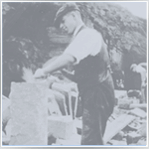


Stonemasonry is one of the earliest trades in the history of civilisation. During the time of the Neolithic Revolution around 10,000 BC, when man began to domesticate animals, farm the land and build static communities, people learned how to use fire to create quicklime, plasters, and mortars. They used these to fashion homes for themselves with mud, straw or stone giving rise to the discipline known today as stonemasonry.
Ancient civilisations relied heavily on the stonemason to build their most impressive and enduring cultural monuments. The Egyptians built their pyramids, the civilisations of Central American created step pyramids, the Persians their palaces, the Greeks their temples, and the Romans their public works and wonders.
Castle building was an entire industry for medieval stonemasons. When the Western Roman Empire fell, building in dressed stone decreased in much of Western Europe with a resulting increase in timber-based construction. Stone work experienced a resurgence in the 9th and 10th centuries in Europe, and by the 12th century religious fervour resulted in the construction of thousands of impressive churches and cathedrals in stone across the continent.
Medieval stonemasons' skills were in high demand, and membership of the associated guild, gave rise to three classes of stonemasons: Apprentices, Journeymen, and Master Masons. Apprentices were indentured to their masters as the price for their training, journeymen had a higher level of skill and could go on journeys to assist their masters, and master masons were considered free men who could travel as they wished to work on the projects of their patrons. A medieval stonemason would often carve a personal symbol onto their block to differentiate their work from that of other stonemasons.
The Renaissance saw stonemasonry return to the prominence and sophistication of the Classical age. The rise in Humanist philosophy gave people the ambition to create marvelous works of art. The centre stage for the Renaissance would prove to be Italy, where city-states such as Florence erected great structures, including the Cathedral of Santa Maria del Fiore, the Fountain of Neptune, and the Laurentian Library which was planned and built by Michelangelo Buonarroti, a famous stonemason of the Renaissance.
When Europeans settlers spread to other continents they brought the stonemasonry techniques of their respective homelands with them. Settlers used what materials were available, and in some areas stone was the material of choice. In the first waves, building mimicked that of Europe, to eventually be replaced by unique architecture later on.
In the late 19th and early 20th centuries stonemasonry saw its most radical changes in the way work was accomplished. Prior to the 1850's, most heavy work was carried out with the aid of draft animals or hired labour. The arrival of steam power and subsequently the internal combustion engine meant that many of the harder aspects of the trade were simplified but the Master Mason's skill and ability to carve and shape stone remains substantially unchanged.
Ancient civilisations relied heavily on the stonemason to build their most impressive and enduring cultural monuments. The Egyptians built their pyramids, the civilisations of Central American created step pyramids, the Persians their palaces, the Greeks their temples, and the Romans their public works and wonders.
Castle building was an entire industry for medieval stonemasons. When the Western Roman Empire fell, building in dressed stone decreased in much of Western Europe with a resulting increase in timber-based construction. Stone work experienced a resurgence in the 9th and 10th centuries in Europe, and by the 12th century religious fervour resulted in the construction of thousands of impressive churches and cathedrals in stone across the continent.
Medieval stonemasons' skills were in high demand, and membership of the associated guild, gave rise to three classes of stonemasons: Apprentices, Journeymen, and Master Masons. Apprentices were indentured to their masters as the price for their training, journeymen had a higher level of skill and could go on journeys to assist their masters, and master masons were considered free men who could travel as they wished to work on the projects of their patrons. A medieval stonemason would often carve a personal symbol onto their block to differentiate their work from that of other stonemasons.
The Renaissance saw stonemasonry return to the prominence and sophistication of the Classical age. The rise in Humanist philosophy gave people the ambition to create marvelous works of art. The centre stage for the Renaissance would prove to be Italy, where city-states such as Florence erected great structures, including the Cathedral of Santa Maria del Fiore, the Fountain of Neptune, and the Laurentian Library which was planned and built by Michelangelo Buonarroti, a famous stonemason of the Renaissance.
When Europeans settlers spread to other continents they brought the stonemasonry techniques of their respective homelands with them. Settlers used what materials were available, and in some areas stone was the material of choice. In the first waves, building mimicked that of Europe, to eventually be replaced by unique architecture later on.
In the late 19th and early 20th centuries stonemasonry saw its most radical changes in the way work was accomplished. Prior to the 1850's, most heavy work was carried out with the aid of draft animals or hired labour. The arrival of steam power and subsequently the internal combustion engine meant that many of the harder aspects of the trade were simplified but the Master Mason's skill and ability to carve and shape stone remains substantially unchanged.

